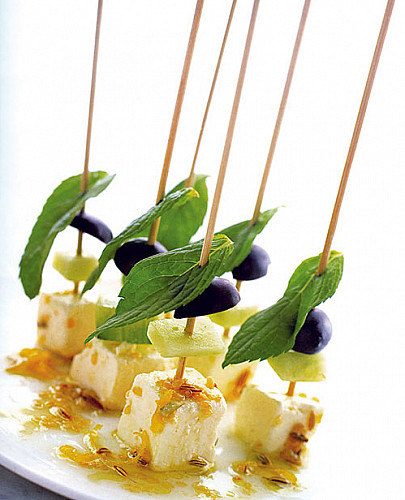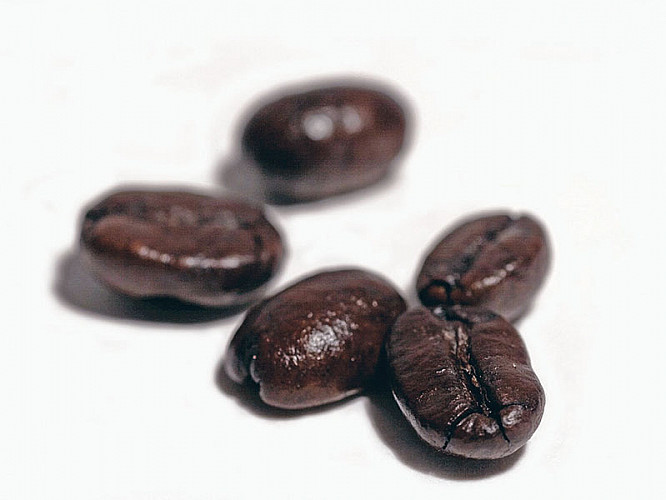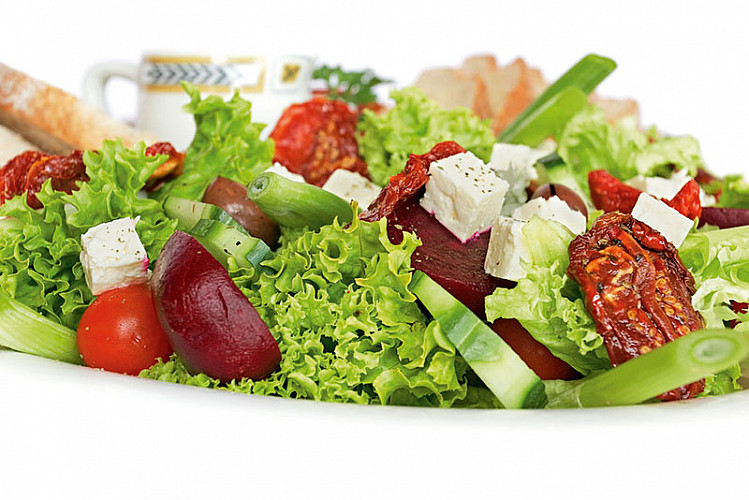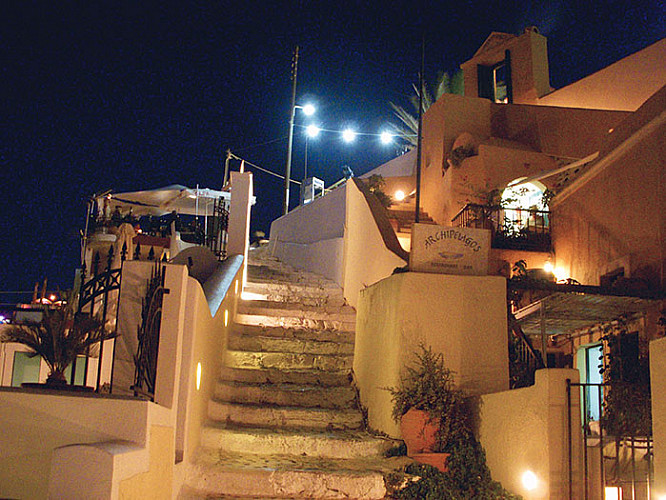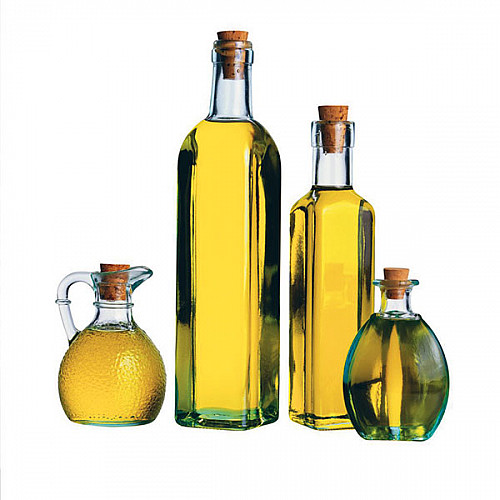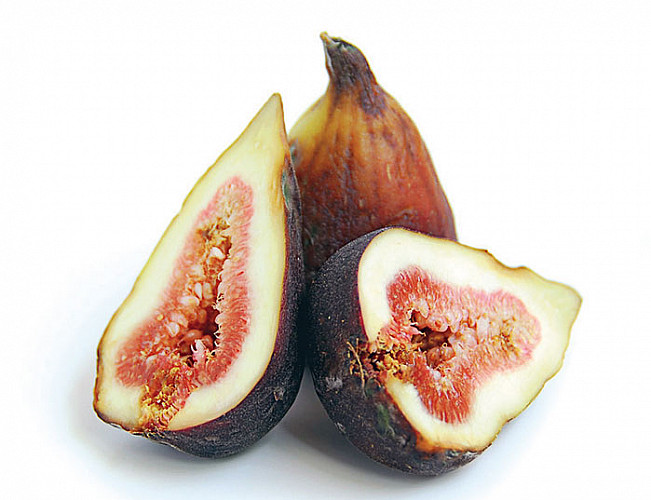Ouzo & Meze
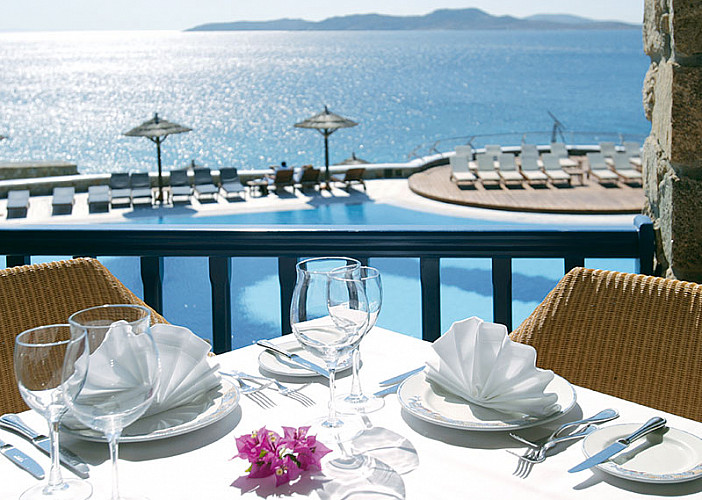
Virginity represents the epitome of purity. And a dash of extra virginity is purity magnified. Something so basic has been turned into the lifeblood of a country, into an industry and into a staple. Olive oil, spectacularly virgin, blessedly enhanced with features that are the true test of nature, denuded from the bountiful olive’s original sourness, marinated in herbs like fennel and finally spiked to culinary satisfaction. Olive oil is to Greece, what wine is to France. Drench a traditional Greek salad with it, observe it slide down the hefty chunk of feta cheese, creating rivulets around the oregano seasoning and watch it play a merry hide-and-seek with the folds of crisp lettuce, mountains of cucumber, mounds of olives and soft hills of ripe tomatoes until it arrives peacefully at the bottom of the bowl, waiting to be swished back up with flecks of freshly ground pepper. Ah!
Tourists come and tourists go, and they always leave with a distinct sense of Greece, emblazoned in her cuisine, and the pride with which the locals present their food to the hungry-eyed. With some grudging leeway made for Continental preparations (Greek with a French twist, dashed off with a healthy serving of Italian), it is tough to find truly international cuisine in Greece. Rightly so, for, would one wish to eat paneer tikka or sushi whilst basking in the Mediterranean?
Strolling down Athens’ Adrianou Street, a merry pedestrian path, in the vicinity of Plaka, I am spoilt for options. A host of family-run restaurants and street cafés vie for attention, as lissome Greek men prowl around attempting to charm a wayward tourist into their culinary lair. Uncles, brothers and nephews are all out in full force, with wickedly greasy smiles pasted on for the unsuspecting visitor who hovers expectantly at the entrance, flipping pages of their laminated menus, and once the walk has been made towards the table, they flit quickly to the next victim; I can only assume that the omnipresent mothers, wives, aunts and nieces are all back in the kitchen cooking up something truly divine!
Choosing the restaurant with the coziest ambience and flickering candles, we slide into one of the crammed tables, and order ouzo – local anise-flavoured alcohol. Likened to the absinth or local fenny, ouzo is so strong (80-proof) that even the local Greeks chase it with water and always eat some meze to lighten the impact. Nothing fancy – something simple like bread doused in olive oil accompanied with a homemade dip, or feta and olives, works. (Beware the tricky ‘cover’ charge, that every table is inadvertently slapped with – for water and bread – whether ordered or not!)
If alcohol isn’t your cup of tea, then try the local Greek coffee, a chilled foam-topped drink popularly known as frappé or fréddo. For those who believe that Starbucks invented frappés, think again! Discovered by an employee of Nestlé way back in 1957 in Thessaloniki, the Greek frappé has its own variations in the iced espresso or cappuccino fréddo. In Greece, the local iced coffees are so popular that the trademark tall, slim glass, brimming with dark brown liquid swirled with pale froth is the drink of choice on sunny beaches, in lieu of fancy cocktails.
Food is a strange thing – even months, or years after having eaten something delectable, it is possible to conjure up, in the mind’s eye, the very taste, the flavour and aroma… In how many places though, is it possible to savour the changing hands of the season? The Greeks are purely seasonal eaters – the horiatiki salata (Greek salad), popular in summer, gets replaced by some version of lachano-marouli salata (cabbage-lettuce salad) at any other time of the year. The healthiest food in winter is the horta or wild greens, steamed or blanched and deftly made into a salad, with a dash of lemon juice and olive oil, eaten as a light meal with potatoes (in lieu of fish or meat). Watching the locals spend hours bantering or watching a community TV over the appetizers and salad, we begin to feel right at home.
As the moon lights up the Acropolis, our main course is served in steaming platters. From a freshly baked spanakopita (spinach and feta stuffed filo pie) to moussaka (a minced lamb and eggplant casserole), stuffed peppers, and pastitsio (a baked meat dish with béchamel sauce) there is much to choose from. Meat is in abundance in Greece – grilled lamb chops, pork and meatballs, and not forgetting game stew and grilled octopus. We look for kat which identifies frozen items on the menu, as the Greeks, by law, must make mention of anything that is not fresh. These baked dishes are great on the mainland, but the islands have their own specialties, though olive oil remains an ubiquitous ingredient across the country.
On the Cycladic islands, a few days later, as I watch the multi-toned hues of the Santorini sunset reflect onto the burgundy wine, throwing shadows onto mashed fava (split pea) puree drizzled with olive oil and roasted onions, I automatically reach for the blood red tomato balls, as if colour must match colour, in order to synchronize with nature. The melting carafe of local Santorini wine, springing from the volcanic temperament of the soil and microclimate, is as unique as the local produce, giving us waterless yet succulent cherry tomatoes, sweet and sturdy white aubergines (both owing their origins in Suez), piquant green capers and cheese cultivated at home and served fresh, daily.
Hobnobbing with the locals gets us an inside peek into some interesting tastes that grab our palette – louloudakia or stuffed zucchini flowers (a dish found in Lesvos) which can be deep fried with cheese or boiled and stuffed with rice and herbs. And a local appetizer popularised in the Mykonos taverns, louza, a deep ruby-coloured ham flavoured with spices, left to dry and sliced particularly thin.
It is simply sinful to leave Greece without having experienced the popular Greek fast food of gyro (pita sandwich with rotisseried meat, accompaniments and tzatziki sauce) and souvlaki (cubes of meat on skewers). We steadfastly maintain that neither dish tasted remotely close to the original, hole-in-the-wall version, when attempted at a fancy restaurant. It is not difficult to find a little joint in the island towns or on street corners in Athens. A corn-on-the-cob and roasted pistachios from the little street vendors work as great accompaniments.
The generous physical proportions of the Greeks is not surprising, what with a daily dose of lovingly syruped layers of delicacies – from Turkish baklava and melitinia (small cream cheese pies) to the Mykonos specialty of roasted marzipan. For a lighter dash of sweetness, there is always the local seasonal fruit (giant juicy figs, melons and pears) or my personal favourite – yoghurt doused with fresh fruit, honey and groundnuts – the famous local concoction, particularly delicious, creamy and thick.
As I sit back, sipping on the local digestive liqueur masticha, swirling the flavour of anise around my tongue, after twelve days of food tasting in the land of myth and history, I feel like I am a part of another world, a world rich in food and culture, and yet simple to the core. Maybe it is the lack of popularisation of Greek cuisine abroad, or the fact that when in Greece, get fed like the Greeks do, that I feel content. Or maybe it is all those chunks of feta swirling in extra virgin olive oil…
Island Fare
On Santorini
1800, Oia – Introducing the concept of ‘slow food’ with excellent Mediterranean cuisine, hosted in a one-time-sea-captain’s mansion. Time slides by in the midst of cascading herbs and subtle sauces, and authentic furniture and lithographs dating back to 1850.
Archilepagos, Fira – Standing tall at Fira town, with a spectacular view down to the caldera, classic Mediterranean.
Café NRG Creperie, Fira – Excellent meal-to-go, with all kinds of crêpes (even with Indian curry and Mexican tortillas).
Nichteri and Classico, Kamari – Poised next to each other, it takes many a moment to decide which one to opt for – the former being the more gourmet version of the other, both classic Greek restaurants.
Senõr Zorba, Ag. Irini, Pyrgos – Away from the buzz, this peaceful Mexican haven with sweeping views over the caldera, concocts a mean avocado dip.
On Mykonos
Nammos, Psarou Beach – Sprawling onto private Mediterranean beach sands, this sophisticated fine dining place is popular with the jet-setting crowd for its crisp innovative salads, zucchini balls and fresh seafood (lobster-pumpkin risotto).
Appaloosa, Mykonos Town – Eva, the owner, turns this Mexican fiesta joint into a feisty, rollicking one, with rockin’ margaritas and mojitos, zesty fresh salsa and charm galore.
Aqua, Little Venice, Mykonos Town – Perched precariously on the pebbled waters, the little joint faces the famous Mykonian windmills, and makes for a perfect romantic dinner, where fresh seafood pasta with layers of cream and contrasting flavours make the Italian dish come alive, accompanied by a perfectly matched bottle of wine.
Related posts from Verve:
Verve Trending
Sorry. No data so far.
us on Facebook to stay updated with the latest trends

